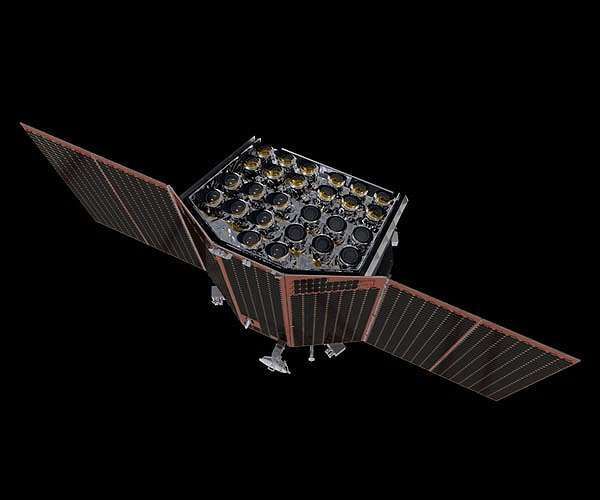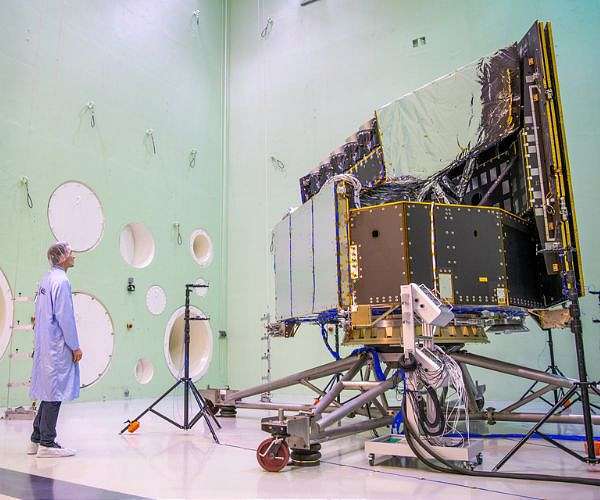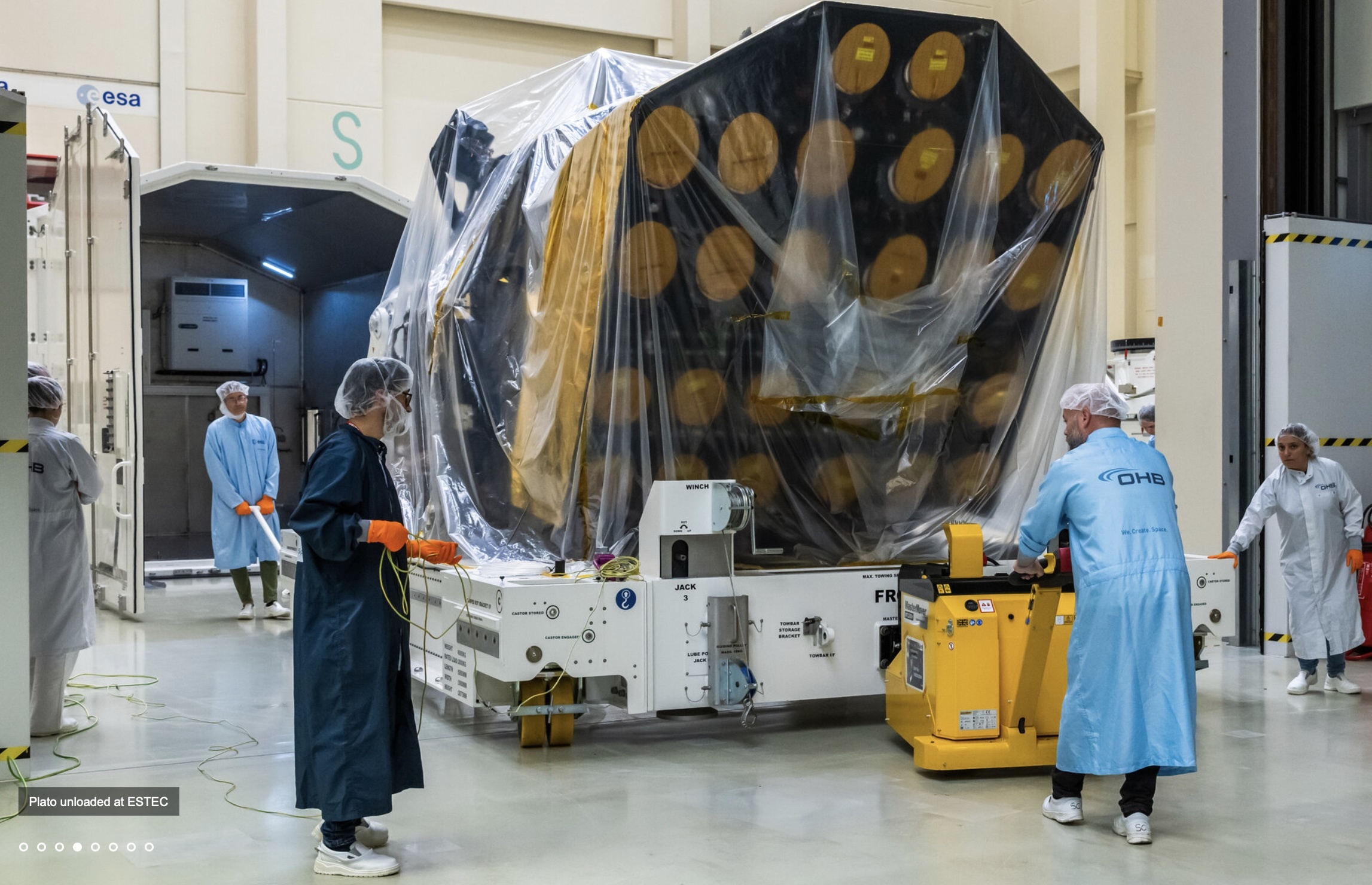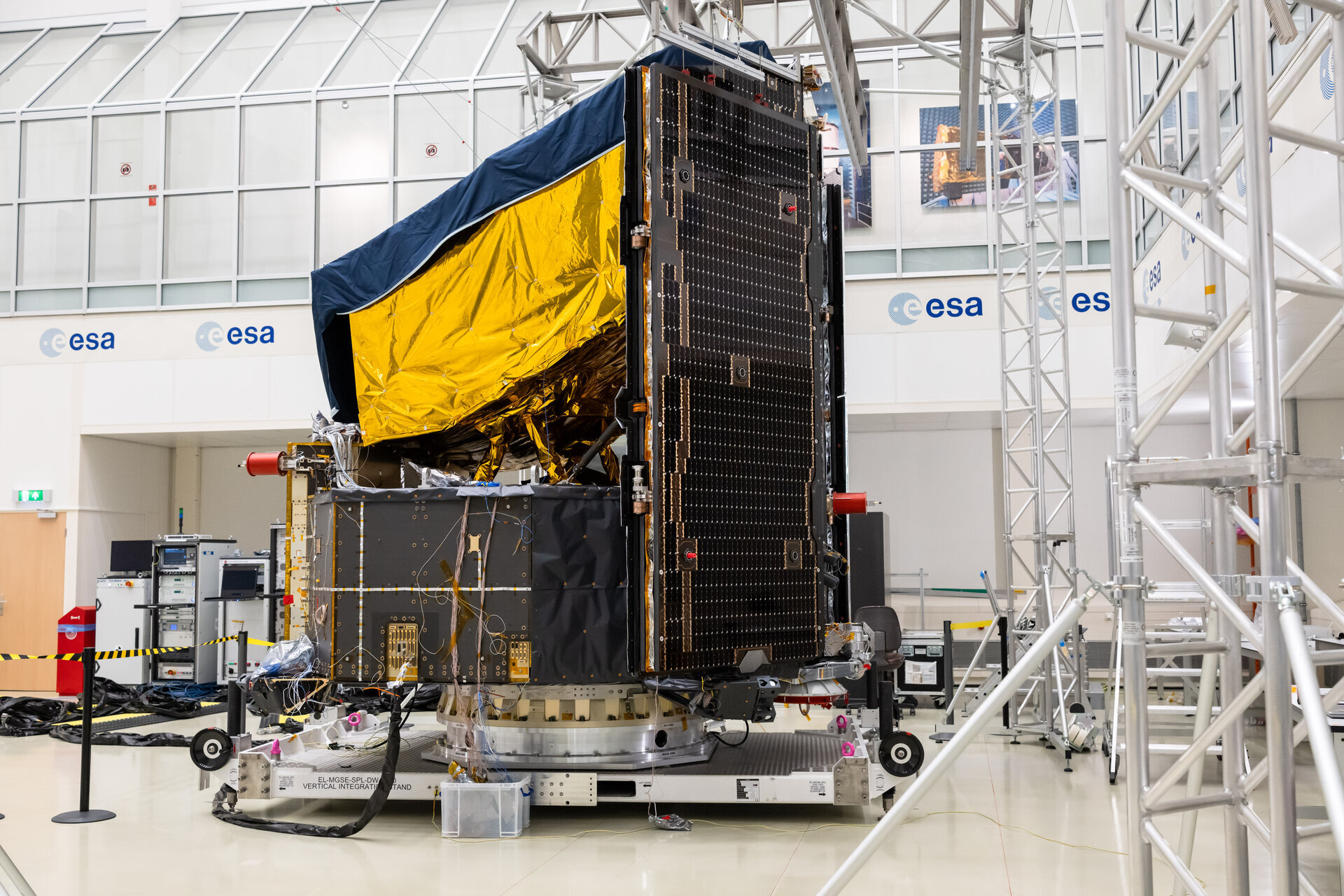21.07.2024

Europe's upcoming space mission, a telescope designed to search for Earth-like planets beyond our solar system, is scheduled for launch at the end of 2026.
The telescope, known as PLATO (PLAnetary Transits and Oscillations of stars), aims to find nearby potentially habitable planets around Sun-like stars for detailed examination.
The spacecraft will be launched on Europe's new Ariane-6 rocket, which had its inaugural flight last week and was developed at a cost of euro 4 billion ( Pounds 3.4 billion).
Dr. David Brown from the University of Warwick is presenting an update on the mission at the Royal Astronomical Society's National Astronomy Meeting at the University of Hull this week.
"PLATO's goal is to search for exoplanets around stars similar to the Sun and at orbital periods long enough for them to be in the habitable zone," he said. "One of the main mission objectives is to find another Earth-Sun equivalent pair, but it is also designed to carefully and precisely characterise the exoplanets that it finds (i.e. work out their masses, radii, and bulk density)."
In addition to its primary mission of hunting exoplanets, PLATO will also perform stellar science. It will study stars using various techniques, including asteroseismology, which measures star vibrations and oscillations to determine their masses, radii, and ages.
PLATO stands out with its multiple cameras, including one named ArthurEddington after the renowned astronomer and physicist who won the Royal Astronomical Society's prestigious Gold Medal in 1924.
The telescope features 24 'Normal' cameras (N-CAMs) and 2 'Fast' cameras (F-CAMs). The N-CAMs are grouped into four sets of six cameras, each set pointing in the same direction but slightly offset from the others.
This configuration provides PLATO with a large field of view, enhanced scientific performance, redundancy against failures, and a built-in method to identify 'false positive' signals that could mimic an exoplanet transit, Dr. Brown explained.
"The planned observing strategy is to stare at two patches of sky, one in the North and one in the South, for two years each," he added. "The Southern patch of sky has been chosen, while the Northern patch won't be confirmed for another few years."
Several spacecraft components are nearing the end of their manufacturing and calibration tests, including the UK-provided Front-End Electronics (FEE) for the N-CAMs.
These components, built by the Mullard Space Science Laboratory at University College London, operate the cameras, digitize the images, and transfer them to the onboard data processing system.
Ten of the final cameras have been built and tested, with the first of these mounted onto the optical bench-the structure that keeps all cameras pointed correctly-earlier this year.
The mission is on track to launch in December 2026.
Quelle: SD
----
Update: 4.02.2025
.
PLATO mission set for late 2026 launch aboard Ariane 6

On January 29, 2025, senior officials from the European Space Agency (ESA) and Arianespace formalized the launch contract for ESA's PLATO science mission. The agreement was signed by Carole Mundell, ESA's Director of Science; Toni Tolker-Nielsen, ESA's Director of Space Transportation; and Steven Rutgers, Chief Commercial Officer of Arianespace. The German Aerospace Center (DLR) is playing a key role in the PLATO mission, leading the payload consortium and contributing vital electronics for two critical cameras, in addition to its significant scientific involvement.
The German contribution to PLATO is supported by the German Space Agency at DLR through funding from the Federal Ministry for Economic Affairs and Climate Action (BWMK), along with core funding from DLR and the Max Planck Society. The contract signing took place at the European Space Conference in Brussels, Belgium. PLATO is scheduled to lift off from Europe's Spaceport in French Guiana aboard an Ariane 6 rocket equipped with two boosters in late 2026.
PLATO, short for PLAnetary Transits and Oscillations of stars, is being developed by an industrial core team led by OHB Bremen, working alongside ThalesAlenia Space and Beyond Gravity. The Max Planck Institute for Solar System Research in Gottingen is overseeing the development and operation of the PLATO Data Center (PDC), which will handle data calibration and validation while generating high-quality scientific data products.
The PLATO spacecraft has a distinctive design tailored for astronomical observations. Instead of employing a single large telescope, it features 26 individual lenses equipped with cameras mounted on an optical bench, enabling a much broader field of view than conventional space telescopes.
Searching for Earth-like planets in the Milky Way
PLATO's primary mission is to discover Earth-like exoplanets orbiting Sun-like stars in the Milky Way, particularly those that might have conditions suitable for life. To achieve this, the spacecraft will be positioned at Lagrange point 2 (L2), a stable region in space 1.5 million kilometers from Earth along the Sun-Earth axis. This location, also home to the James Webb Space Telescope, allows PLATO to conduct continuous, uninterrupted observations without interference from Earth's atmosphere.
PLATO will utilize its 26 cameras to observe approximately 200,000 stars in overlapping fields of view. The mission will detect exoplanets using the transit method, which measures tiny dips in starlight when a planet passes in front of its host star, temporarily dimming its brightness.
Understanding Lagrange point 2
Lagrange point 2 (L2) is an optimal location for space telescopes due to its gravitational stability, allowing satellites to remain in a fixed position relative to Earth and the Sun with minimal fuel expenditure. L2 offers an ideal vantage point for deep-space observations, providing a stable environment free from terrestrial radiation while ensuring continuous communication with Earth.
"This mission will bring us closer to answering one of humanity's most important questions: Has life also developed on other planets?" said Heike Rauer from the DLR Institute of Planetary Research and Freie Universitat Berlin, who leads the payload consortium for the PLATO mission.
Ariane 6, Europe's latest heavy-lift rocket, successfully launched its first flight in July 2024, with a second mission scheduled for February 2025. As the launch cadence increases, Ariane 6 is expected to provide greater flexibility and cost efficiency compared to its predecessor. The rocket's modular design, featuring an upgraded main stage, configurable boosters, and a restartable upper stage, ensures adaptability for various mission profiles.
Quelle: SD
----
Update: 13.09.2025
.
Plato arrived at ESA’s test centre by boat

The European Space Agency’s Plato spacecraft has safely arrived at ESTEC, ESA’s technical heart in the Netherlands. There, engineers will complete the spacecraft by connecting its solar panels and sunshield, and carry out a series of critical tests to confirm that Plato is fit for launch and ready for its planet-hunting mission in space.
The two main parts of the Plato spacecraft were recently joined together at OHB's cleanroom in Oberpfaffenhofen, Germany. On 1 September, Plato arrived in the Netherlands by boat from Germany via the Rhine River. The vessel transporting it moored a few km away from ESTEC.
From there, Plato was driven to ESA’s centre by special transport, carefully unloaded, and then moved to a cleanroom.
What's next for Plato

In the coming weeks, engineers will mount the remaining essential part of the spacecraft: the combined sunshield and solar arrays module.
With the spacecraft complete, testing will begin. To determine that it can be safely launched, Plato will undergo intense shaking and sound ‘bombardments’ during vibration and acoustic tests.
After these, the spacecraft will be placed into the Large Space Simulator – Europe’s largest vacuum chamber – to verify that it can withstand the extreme temperatures and emptiness of space and work well.
Plato is scheduled to launch on an Ariane 6 rocket in December 2026 on its quest to search for Earth-like planets orbiting stars similar to our Sun.
For this, the spacecraft is equipped with 26 ultrasensitive cameras designed to capture the tiniest variations in the intensity of a star’s light. When planets pass in front of their host stars, they dim the starlight we receive. By capturing and analysing this dimming effect, Plato can spot new exoplanets.
The mission’s focus is to discover planets that circle Sun-like stars in the habitable zone – the ‘goldilocks’ region, where the temperature is just right for liquid water to exist on a planet’s surface. These planets take several months to complete an orbit because of their location: not too close, not too far from their star. To capture them, Plato’s 26 eyes will stare at the same region of the sky continuously for a minimum of two years.
This will also enable Plato to study ‘starquakes’, encoded in subtle changes of a star’s brightness and provide scientists with unique insights into the interiors and ages of stars.
Like other groundbreaking missions such as Webb and Euclid, Plato will peer into space vastness from an orbit around the Sun-Earth Lagrange point 2 (L2), 1.5 million kilometres away.
From this vantage point, the mission will inspect more than 200 000 stars over its nominal lifetime and reveal whether the environment we enjoy on Earth can exist also elsewhere in our galaxy.

About Plato
ESA’s Plato (PLAnetary Transits and Oscillations of stars) will use 26 cameras to study terrestrial exoplanets in orbits up to the habitable zone of Sun-like stars.
Quelle: ESA
----
Update: 9.10.2025
.
Completed Plato spacecraft is ready for final tests

By fitting its sunshield and solar panels, engineers have completed the construction of Plato, the European Space Agency’s mission to discover Earth-like exoplanets. Plato is on track for the final key tests to confirm that it is fit for launch.
The activities to complete Plato started soon after the spacecraft arrived at ESA’s Test Centre in the Netherlands. On 9 September, in a dedicated clean room, engineers prepared for the delicate operation by suspending the combined sunshield and solar panel module from special lifting gear.
They then manoeuvred the module to precisely align it with the back of the spacecraft, and carefully mounted it in place.
“With this operation, we have completed the Plato spacecraft. The combined sunshield and solar array module was the last remaining essential part,” comments Thomas Walloschek, ESA’s Plato Project Manager.
“It is very satisfying to have reached this moment and to see Plato in its final shape. This is the result of an excellent cooperation between ESA, the Plato Mission Consortium members and Plato's industrial core team.”
The sunshield and solar panels are vital elements for the Plato mission. Once in orbit, the solar array catch light from the Sun to generate the electricity needed to power the spacecraft’s electronics. The sunshield keeps the scientific equipment in shadow, away from the Sun’s glare.
“Over the years we have seen what Plato would look like in countless detailed drawings and simulated images, yet seeing the real, completed spacecraft feels very special,” add Ana Heras, ESA’s Plato Project Scientist.
“Plato has a distinctive design, conceived to efficiently integrate its advanced cameras within the spacecraft. Its overall layout is optimised to monitor more than 150 000 bright stars at the same time, with high precision. This will enable scientists to hunt for terrestrial planets orbiting stars similar to our Sun.”
To spot exoplanets, Plato carries 26 advanced cameras tasked with capturing the tiniest variations in the intensity of a star’s light. To achieve the necessary high sensitivity, the cameras must be kept cool, so that each camera is kept at its best-focus temperature around -80° C.
Protected from sunlight by the sunshield and facing deep space, Plato’s scientific instruments will cool down and stay at the required frigid temperature throughout the mission’s lifetime.
Power to Plato
The structure supporting the solar panels and acting as a sunshield wraps around the back of the spacecraft – the part that in orbit will be facing the Sun. During launch the solar panels are kept firmly folded in. Once Plato is in space, they will unfold extending outwards like a pair of wings.
So, after mounting the combined sunshield and solar array module, engineers tested whether it could correctly deploy. They deployed the left and right wing separately, on 16 and 22 September.


Access the video
Because the solar arrays will unfold in space, the deployment test must be carried out as if gravity were absent and the panels were weightless. For this, the panels were suspended from a supporting frame with a system of pulleys that moved along as the panels smoothly unfolded.
Once the panels were deployed, engineers used a special lamp to simulate the effect of sunlight hitting the arrays and verified that they supplied the right level of electricity to the rest of the spacecraft.
This last step confirmed that the deployment was successful.
Tough exams ahead
Plato is on track to launch in December 2026, as originally planned, on an Ariane 6. But, before graduating for launch, the spacecraft will have to pass a series of tough exams.
These involve vigorously shaking the spacecraft and blasting it with powerful noise during vibration and acoustic tests that mimic the mechanical stresses of a rocket launch. Then, placing the spacecraft inside the Large Space Simulator, Europe’s largest cryo-vacuum chamber.
Therein, Plato will get its first taste of space’s harsh environment and will have to demonstrate that it can work flawlessly once in orbit.






